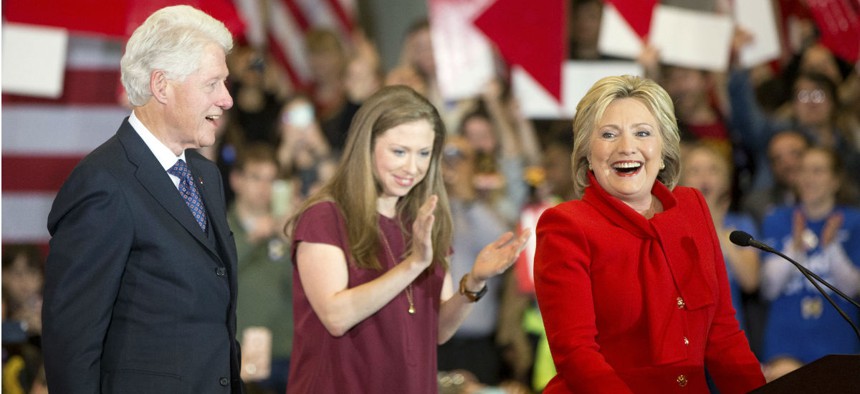
Hillary Clinton arrives at her caucus night rally. Andrew Harnik/AP
Clinton Got Obama's Iowa Tactics, Not His Voters
Sanders' strong showing with young voters highlights the challenge Clinton faces if she wants to replicate the Obama coalition.
Hillary Clinton mastered the Barack Obama organizing tactics, and she has adopted the Barack Obama agenda and legacy.
Now all she has to do is figure out how to win over the Barack Obama voters.
Because while she managed Monday to avoid the crushing loss that she suffered in the Iowa caucuses eight years ago, her virtual tie with Sen. Bernie Sanders will do little to discourage him from pushing full steam ahead into the New Hampshire primary, where most polls show him holding a healthy lead.
And what drove Sanders to his strong showing? Young voters, who, according to entrance polls, broke for Sanders by a 6-1 ratio. (This under-30 age group eight years ago supported then-Sen. Obama overwhelmingly.) Fortunately for Clinton, the majority of those caucusing were over 50, and they broke for her by an average of 25 percentage points Monday night.
In brief remarks late Monday from Des Moines, Clinton acknowledged the razor-thin margin: “I stand here tonight breathing a big sigh of relief—thank you Iowa!”
She said she looked forward to continuing the debate with Sanders in the coming weeks, and repeated a line meant to remind his supporters that she shares their goals and values but also has the experience to deliver results. “I am a progressive who gets things done for people.”
The good news for Clinton, of course, is that the road will soon get a lot easier for her. Iowa’s nearly all-white, extremely liberal Democratic electorate is far more fertile ground for Sanders’s appeal than just about every caucus and primary that comes after New Hampshire. In South Carolina, for example, which votes at the end of the month, African-Americans make up the majority of Democratic voters, and Clinton is far more popular in that community than Sanders is. That primary is followed by the March 1 states, most of them in the South, where Clinton can again count on black support.
Also encouraging for her: She still remains popular with Democratic primary voters, including those who will be voting for Sanders in the coming weeks and months. The vast majority of those attending Sanders campaign events very much like his message and believe his candidacy has forced Clinton to confront his issues and even take positions closer to his—but in the end are almost certain to support Clinton over any Republican come November.
But Clinton’s problem is not just the younger and more-progressive voters who attend Sanders’s rallies. Her problem is with those who agree with Sanders’s views and who supported President Obama eight or four years ago, but who may not be excited enough by her to come out this November—should she manage to get past Sanders this spring.
Young voters are a key element of the “Obama coalition” that delivered him the White House twice. Clinton showed with Monday’s performance that adopting the Obama organizational model—with plenty of on-the-ground staff and heavy on detailed, data-driven turnout—can lead to a draw against a candidate who can attract a big piece of the Obama base.
Between now and November, assuming she winds up the nominee, she will need to get a handle on both halves of the Obama machine if she hopes to follow him to the White House.






